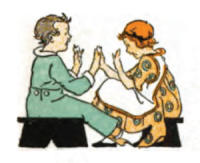Red Rover

Red rover (also known as forcing the city gates and octopus tag) is an outdoor game played primarily by children on playgrounds. This 19th-century children's group game (requiring around 10 or more players total)[1] is thought to have originated in Britain and then spread to Australia, Canada and the United States.
Røver is a Norwegian word for "robber", so perhaps the early British were showing bravery by daring the Viking raiders to "come over". The 1829 book titled The Red Rover: A Tale by James Fenimore Cooper describes the exploits of a pirate called "Red Rover".[2]
Game
The game is played between two lines of players, usually around thirty feet apart. The game starts when the first team (usually called the "East" or "West" team, although this does not relate to the actual relative location of the teams) calls out, "Red rover, red rover, send [name of player on opposite team] right over." or "Red Rover, Red Rover, let [name of player of opposing team] come over." or "Red rover, red rover, we call [name of player on opposite team] over."
The immediate goal for the person called is to run to the other line and break the "East" team's chain (formed by the linking of hands). If the person called fails to break the chain, this player joins the "East" team. However, if the player successfully breaks the chain, this player may select either of the two "links" broken by the successful run, and take them to join the "West" team. The "West" team then calls out "Red rover" for a player on the "East" team, and play continues.
When only one player is left on a team, they also must try and break through a link. If they do not succeed, the opposing team wins. Otherwise, they are able to get a player back for their team.[1][3]
South Africa
A game of the same name is played in South Africa by school children; however, the rules of this game are identical to British Bulldogs.
Risks
As with any game involving physical contact between players, there are those who maintain that its inherent risks, however unlikely, must be weighed against the pastime's potential to generate personal enjoyment. For example, when the runner breaks through a link (or attempts to break through), it is worried that the action can hurt the linkers' arms or body or knock these individuals to the ground. Particularly discouraged practices include: linking players hand-to-wrist or hand-to-arm (players should hold hands only), "clotheslining" an opposing player at throat height, or extending the hands so an onrushing player runs into a fist. It is very likely that "clotheslining" players (a term indicating when a runner is hit in the throat with the linkers' arms) will lead to injuries.
Popular culture
A 2010 PBS documentary, New York Street Games, includes red rover.[4]
See also
- British bulldogs (game)
- Hana Ichi Monme (a similar Japanese game)
- Tag (game)
References
- ↑ 1.0 1.1 "Red Rover: A Traditional Favorite Outdoor Game". About.com. Retrieved 27 October 2010.
- ↑ Walker, Warren S. "Plots and Characters in the Fiction of James Fenimore Cooper", James Fenimore Cooper Society Website.
- ↑ "Red Rover". Gameskidsplay.net. 2007-01-28. Retrieved 2010-06-26.
- ↑ New York Street Games (Motion picture). New York City. Retrieved 14 Nov 2011. Unknown parameter
|people2=ignored (help); Unknown parameter|people1=ignored (help)
| |||||||||||||||||||||||||||||||
